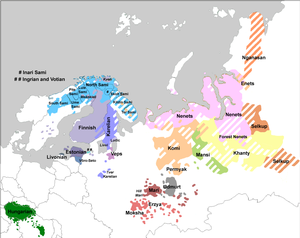lingvo.wikisort.org - Language
The Mordvinic languages,[1] also known as the Mordvin,[2] Mordovian or Mordvinian languages (Russian: мордовские языки, mordovskiye yazyki),[3] are a subgroup of the Uralic languages, comprising the closely related Erzya language and Moksha language, both spoken in Mordovia.[4]
| Mordvinic | |
|---|---|
| Ethnicity | Mordvins |
| Geographic distribution | Southwestern and Southeastern Russia |
| Linguistic classification | Uralic
|
| Subdivisions | |
| Glottolog | mord1256 |
Previously considered a single "Mordvin language",[5] it is now treated as a small language grouping.[6] Due to differences in phonology, lexicon, and grammar, Erzya and Moksha are not mutually intelligible.[7] The two Mordvinic languages also have separate literary forms. The Erzya literary language was created in 1922 and the Mokshan in 1923.[8]
Phonological differences between the two languages include:[5]
- Moksha retains a distinction between the vowels /ɛ, e/ while in Erzya, both have merged as /e/.
- In unstressed syllables, Erzya features vowel harmony like many other Uralic languages, using [e] in front-vocalic words and [o] in back-vocalic words. Moksha has a simple schwa [ə] in their place.
- Word-initially, Erzya has a postalveolar affricate /tʃ/ corresponding to a fricative /ʃ/ in Moksha.
- Next to voiceless consonants, liquids /r, rʲ, l, lʲ/ and the semivowel /j/ are devoiced in Moksha to [r̥ r̥ʲ l̥ l̥ʲ ȷ̊].
The medieval Meshcherian language may have been Mordvinic or close to Mordvinic[citation needed].
Classification
Traditionally, Uralicists grouped the Mordvinic and Mari languages together in the so-called Volgaic branch of the Uralic family; this view was however abandoned in the late 20th century.[9] Instead, some Uralicists now prefer a rapid expansion model, with Mordvinic as one out of nine primary branches of Uralic; others propose a close relation between Mordvinic with the Finnic and Saamic branches of Uralic.[10][11][12]
References
- Bright, William (1992). International Encyclopedia of Linguistics. Oxford University Press. ISBN 978-0-19-505196-4.
- Mordvin languages @ google books
- Dalby, Andrew (1998). Dictionary of Languages. Columbia University Press. p. 429.
Erza.
- Grenoble, Lenore (2003). Language Policy in the Soviet Union. Springer. p. A80. ISBN 978-1-4020-1298-3.
- Raun, Alo (1988). Sinor, Denis (ed.). The Uralic languages: Description, history and foreign influences. BRILL. p. A96. ISBN 978-90-04-07741-6.
- Hamari, Arja; Ajanki, Rigina (2022). "Mordvin (Erzya and Moksha)". In Marianne Bakró-Nagy; Johanna Laakso; Elena Skribnik (eds.). The Oxford Guide to the Uralic Languages. Oxford University Press. pp. 392–431.
- Феоктистов А. П. Мордовские языки. основы финно-угорского языкознания. Прибалтийско-финские, саамский и мордовские языки. М., 1975
- Wixman, Ronald (1984). The Peoples of the USSR. M.E. Sharpe. p. A137. ISBN 978-0-87332-506-6.
- Abondolo, Daniel (1988). The Uralic Languages. London & New York: Routledge. p. 4.
[...] the idea, once widely-held, that there was a common Mordva-Mari protolanguage (so-called 'proto-Volgaic') is now out of favour.
- Nichols, Johanna (2021). "The Origin and Dispersal of Uralic: Distributional Typological View". Annual Review of Linguistics. 7: 351–369. doi:10.1146/annurev-linguistics-011619-030405.
- Saarikivi, Janne (2022). "The divergence of Proto-Uralic and its offspring: A descendant reconstruction". In Marianne Bakró-Nagy; Johanna Laakso; Elena Skribnik (eds.). The Oxford Guide to the Uralic Languages. Oxford University Press. pp. 28–58.
- Piispanen, Peter S. (2016). "Statistical Dating of Finno-Mordvinic Languages through Comparative Linguistics and Sound Laws" (PDF). Fenno-Ugrica Suecana Nova Series. 15: 1–58.
На других языках
[de] Mordwinische Sprachen
Die mordwinischen Sprachen (mordwinisch мокшэрзянь, mokschersjan, mokšèrzjan) gehören zur wolgafinnischen Gruppe der finno-ugrischen Sprachen. Sie werden im Ostteil des europäischen Russland von den Mordwinen gesprochen, die aber zu weniger als einem Drittel als Titularnation in der Republik Mordwinien leben. Bei der letzten Volkszählung der Sowjetunion 1989 gaben 67 % der ca. 1,2 Mio. Mordwinen an, Mordwinisch als Muttersprache zu benutzen. Die am nächsten verwandte Sprache ist das Mari.- [en] Mordvinic languages
[fr] Langues mordves
Les langues mordves[1] sont une famille de deux langues : l'erzya et le mokcha[2], parlées par les Mordves en Russie. Elles se rattachent à la branche finno-ougrienne de la famille des langues ouraliennes. Cet ensemble aurait aussi compris trois langues éteintes : le mérien[3], le mouromien[4], et le mechtchérien[5].[it] Lingue mordvine
Le lingue mordvine sono un ramo delle lingue uraliche parlate in Russia e in altri stati ex sovietici.[ru] Мордовские языки
Мордовские языки входят в состав финно-волжской группы финно-угорской ветви уральской языковой семьи. Мордовская группа состоит из двух языков — мокшанского и эрзянского. Мордовские языки распространены в России на территории Мордовии, Чувашии, Татарстана и Башкортостана, а также в Нижегородской, Оренбургской, Пензенской, Рязанской, Самарской, Саратовской, Тамбовской и Ульяновской областях. Мокшанский и эрзянский являются официальными языками Республики Мордовия, наравне с русским. Судя по сообщению князя Курбского о том, что у мещеры «мордовский» язык, и по топонимам, мещерский язык также относился к мордовским языкам.Другой контент может иметь иную лицензию. Перед использованием материалов сайта WikiSort.org внимательно изучите правила лицензирования конкретных элементов наполнения сайта.
WikiSort.org - проект по пересортировке и дополнению контента Википедии
